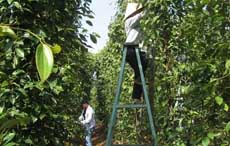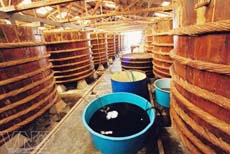Been there, done that. This is what people generally say after they've visited a tourist spot and enjoyed all the comforts and entertainment the place has to offer. Then they go to the next beautiful spot on their agenda.
 |
| Locals work in a pepper plantation on Phu Quoc Island. |
On Phu Quoc Island, the unspoilt beaches, the perfect conditions for fishing, scuba diving or snorkelling, and other leisurely pursuits like hiking and shopping have been bringing in increasing numbers of visitors every year.
When we went there, the island was already a famous place and we thoroughly enjoyed all its attractions. On the last day the tour, our guide took us to the Duong Dong Market so we could buy local specialties as presents to take away.
From the market, we wandered across the Nguyen Trung Truc Bridge, also named Duong Dong Bridge which spans the river of the same name. There we saw an old woman selling medicinal herbs. Curious, we wanted to find out what she was selling.
That one meeting with the old vendor of herbs changed the nature of the tour for us. It made us look afresh at the island, seeing it not just as a extraordinarily beautiful place, but also as a place with a healing touch and its own local stories that we could learn if we paid close attention.
The wise old woman told us she'd been selling these herbs for more than 30 years. Most of fresh herbs had been picked from Phu Quoc's forest. She also told us that Phu Quoc was an isolated island and its residents used herbal remedies from the forest to treat diseases and other forms of illness.
Pick a peck of peppers
This incident opened our eyes to other possibilities in Phu Quoc, where tourism activities were mainly concentrated on its south side.
We decided to visit the northern part of the island that sees visitors far less frequently. We was told that the easiest way to get there was by motorbike so we rented a trusty looking Honda and followed our map.
Just 15 minutes later, we reached a small pepper plantation. The vines grew lush and think around supporting poles to a height of about 5m. Fresh peppers were plucked from the vines and processed into various specialty products that retained their natural green colour and flavour. We learnt that this was a specialty of the island that was used widely in instant soups and dry-meals on account of its special characteristics and subtle flavour.
"It is said that Phu Quoc pepper is much more aromatic and spicy than other varieties of pepper found elsewhere in Viet Nam," a local girl told us.
She said that from October to May, harvested peppercorns are dried in the sun and turned into the black pepper we see in the market place. They are also soaked in water for about 10 days and shelled to produce white pepper, she added.
Wandering around the pepper plantation, we met a holidaying German family who were taking a tour of the agricultural, forestry and fisheries industries of Phu Quoc. The parents wanted their children to see both the wild life of Phu Quoc and experience a different culture.
After talking with them for sometime they asked if we wanted to join them for the rest of the day. The more the merrier, we thought, and agreed quickly. We bought a few kilos of peppercorns and headed to the forest.
We felt the cool and fresh air of mountains and forests throughout the 20km ride, and every second of it was exhilirating. Several times, our bike ran across small brooks which were flowing across the path.
Almost without knowing it we were in the forest, with just one path to explore it. Huge, century-old trees stood beside the the sandy path. Many of them had broad, woody flanges at the base of the trunk.
We tried to find another path to get deeper into the forest, but the vegetation was too thick. It was a pity we could not record the sound of thousands of insects and birds singing at the same time. What an experience!
A forest ranger told us said Phu Quoc's forest was the only virgin forest left in southern Viet Nam. The 29,135ha forest was named a National Park in 2001.
From the forest's edge, we headed to Ganh Dau Commune. The temple to national hero Nguyen Trung Truc was our first destination.
Ganh Dau is also famous for its unspoilt beaches with landscapes which were much more pristine than we could ever have imaged.
 |
| A worker pours the fish sauce into a tank at a local fish sauce processing workshop. |
This part of the island was pretty windy the day we visited. There were almost no tourist facilities here either. Villagers earned their living by fishing. People seemed to live a simple but happy life here. They did not have much, but we felt by their demeanour that they had almost all they needed.
There were a number of restaurants located on the shoreline. The waters were shallow and crystal clear. We saw a restaurant on one of the beaches that looked like a local hangout. The food was exceptional and, as elsewhere in the country, reasonably priced.
We sat content, soaking in the colour of the water, the soft sand beaches, the dark green of the forests and the sunlight that added a special shine to everything around.
On the way back, we visited the Khai Hoan fish sauce factory. Here, fish is mixed with salt and placed in wooden barrels. This company owns hundreds of 10-tonne barrels. After one year of salting, the contents are filtered four times to get high quality and potent fish sauce.
We added a few bottles to our fresh peppercorns and headed home. Been there, done that. And will do so again.